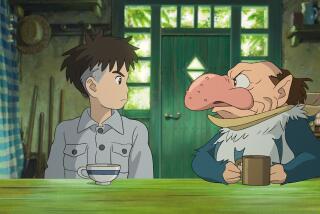Pioneer Paints Portrait of Graphics’ Future
Adobe Systems co-founder and Chief Executive John Warnock was already a graphics pioneer as a University of Utah graduate student, when his doctoral thesis solved a famous difficulty in getting computers to draw realistic lines even when they partially disappear behind objects.
At Xerox PARC in Palo Alto, he and colleague Chuck Geschke, now Adobe’s chairman, led a successful effort to force computer laser printers to print precisely what appeared on a monitor screen. When Xerox dragged its heels on updating its machines, Warnock and Geschke started Adobe in 1982 and signed up Apple as the first big customer for their new typesetting language.
Since then, Adobe’s Acrobat, Photoshop and other products have driven the desktop publishing industry and captured a big piece of document distribution on the World Wide Web.
Warnock spoke with Cutting Edge about the future of computer graphics.
*
Question: What trends do you see in computer graphics now?
Answer: Graphics has really progressed very, very rapidly over the last few years, primarily because computing power has been doubling under Moore’s law [the principle stating that the cost of computing power falls steadily over time].
A big beneficiary is the entertainment industry. With the stuff that Pixar does, and the stuff that [George] Lucas does, there are huge cost savings to be achieved. Most movies depend very, very heavily on computers to deal with almost all of the special effects. In the last “Star Wars,” they hardly had any sets at all.
Animation is also becoming more important on the Web.
*
Q: Let’s talk about video. Is there anything besides bandwidth that’s driving that?
A: As e-commerce really starts to take off and people really determine their branded presence on the Web by the way the Web site looks and feels, graphics and good design are going to become more and more important, the way ad campaigns are.
It’s good news for designers. There are a lot of really awful Web sites out there.
Video has some of the same problems that voice has--it locks you into a linear sequence. I personally can’t deal with voicemail. I’d rather deal with e-mail, where you can scan it.
*
Q: Are most Web sites going to appear in three dimensions, with hyperlinks to jump through?
A: No. Even though we live in a 3-D world and we navigate in it, two dimensions are usually better. Take a store. Everybody says, “Wouldn’t it be neat if you could wander through Nordstrom on the Net?” But that’s really inefficient. You have to walk over the entire store for a specific color of clothing. Pink pants here, pink shirts on the other side of the store.
You have to ask yourself, what value does the three-dimensional process add? If you are looking for a car, it could be very useful. But to think that you’re going to be able to model every object is hopelessly unrealistic with today’s state of the art. Take the telephone. Modeling that is a truly difficult activity.
*
Q: What else is going to be big in the next few years?
A: Digital photography, that’s explosive. Half the video cameras in Japan now are digital cameras.
There’s going to be surprises. Most of the things that I expected to happen have been predicted--the shift of massive amounts of buying power to the Web; that’s all going to happen. That’s going to force companies, including ours, to really focus on how to keep connected to customers who are a click away from another million sites.
*
Q: What are the most common mistakes in Web design?
A: It’s like the first mistakes with desktop publishing. People would say, “We have all these fonts, let’s use them all.”
I think less is more. Too many use garish colors, and they let navigation features dominate the content, and that’s a terrible mistake.
*
Q: What does Adobe have to do next as a company?
A: We did have a rough spot when the Japanese markets went south, but I think the company is on very good footing right now.
It’s clearly an economic benefit for the movie industry to use computers, so it’s sort of a race to see how involved Adobe is going to be. Our strength is in the image-processing side. Every movie that’s made and every set of titles that’s made probably used our stuff.
Siggraph [Assn. for Computing Machinery’s graphics group’s convention, held this week in L.A.] has always been where the “wow” is. If you go visit it, you will see where the leading edge of people’s imagination is. That takes some time to translate back.
Further on, what happens is what’s happened in the publishing business. The cost comes down to the point where you find high school kids doing independent productions. I was at Sundance, and it seems like anybody can make a film.
*
Times staff writer Joseph Menn can be reached at joseph.menn@latimes.com.
More to Read
Inside the business of entertainment
The Wide Shot brings you news, analysis and insights on everything from streaming wars to production — and what it all means for the future.
You may occasionally receive promotional content from the Los Angeles Times.










